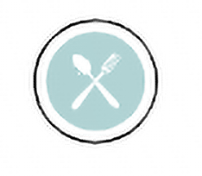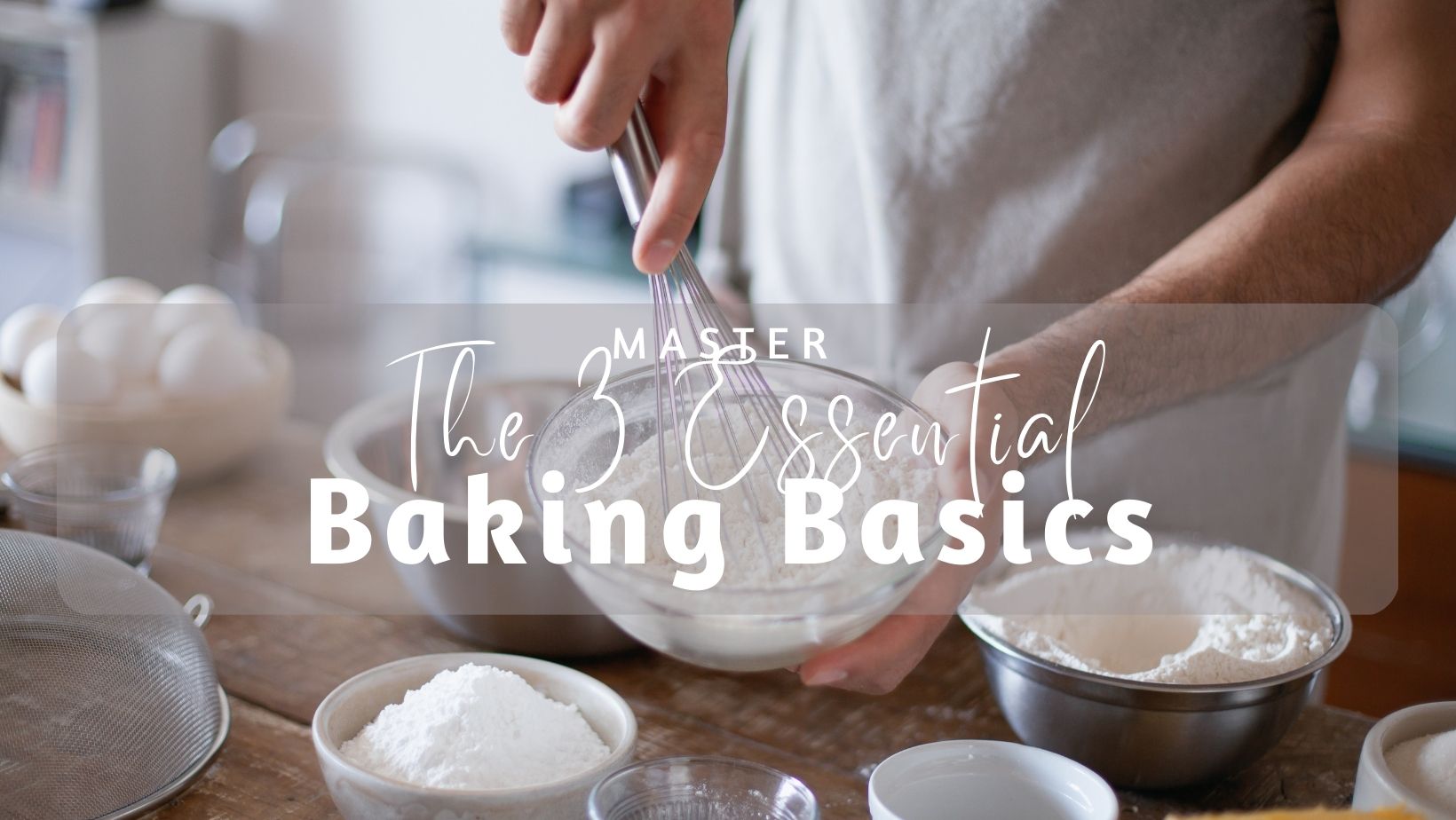Baking is an art form that has been practiced for centuries, it’s a craft that requires some skill and technique, as well as the right ingredients in just amounts, to create the foods we love so much and love to share.
I’ve been a home baker for over 20 years, cooking for loved ones and local cafes, and I believe anyone can be successful by mastering these three key skills we’ll cover today. Mastering these three essential baking skills will give you more control over your results when making cakes, cookies, or other baked goods and with practice and a little dedication, you (and anyone) can go from zero to hero!
It’s also very rewarding; not only do you get to enjoy delicious treats, but there’s also great satisfaction in creating something with your own hands and having something wonderful to share with your loved ones. So, let’s get to it!
Essential Baking Techniques
1. Accurate Measuring
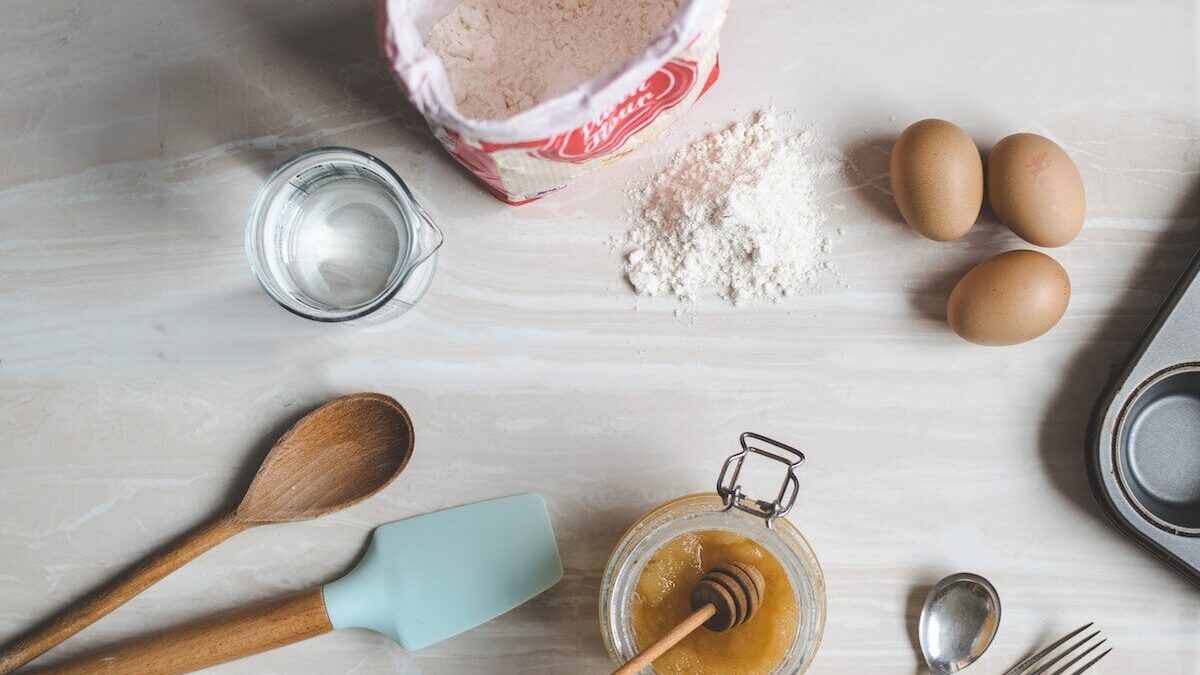
Measuring wet and dry ingredients accurately is another key technique when it comes to baking success.
To start, gather all of your ingredients together on one work surface – this way you can keep track of what goes where and how much is needed for each recipe.
Accurate measuring of ingredients is a critical aspect of successful baking. Here are some important points to keep in mind when measuring ingredients for baking:
- Use the correct measuring tools: Use measuring cups and spoons that are designed for baking, as they provide accurate measurements. Using kitchen utensils such as regular cups or tablespoons may not provide consistent measurements. Also, for better accuracy and consistency, be sure to use measuring cups designed for liquids and others designed for dry ingredients.
- Use a scale: For the best accuracy, use a kitchen scale to weigh ingredients. This is particularly important for recipes that require precise measurements, such as macarons or bread.
- Use level measurements: When measuring flour, sugar, or other dry ingredients, use a straight edge to level off the top of the measuring cup or spoon. This ensures that the measurement is accurate and consistent. When measuring liquids, use a clear measuring cup and check the measurement at eye level. This ensures that the measurement is accurate and consistent.
- Use room temperature ingredients: For recipes that require ingredients such as butter or eggs to be at room temperature, make sure to allow them to come to room temperature before measuring. This ensures that the measurements are accurate and consistent.
- Double-check the recipe: Before adding ingredients, double-check the measurements as noted in the recipe to ensure what you are about to add is what’s actually required. Misreading a recipe is a surprisingly common cause of baking issues.
By following these tips, you can achieve accurate and consistent measurements, which is a fundamental key to successful baking.
2. Basic Batter & Dough Preparation
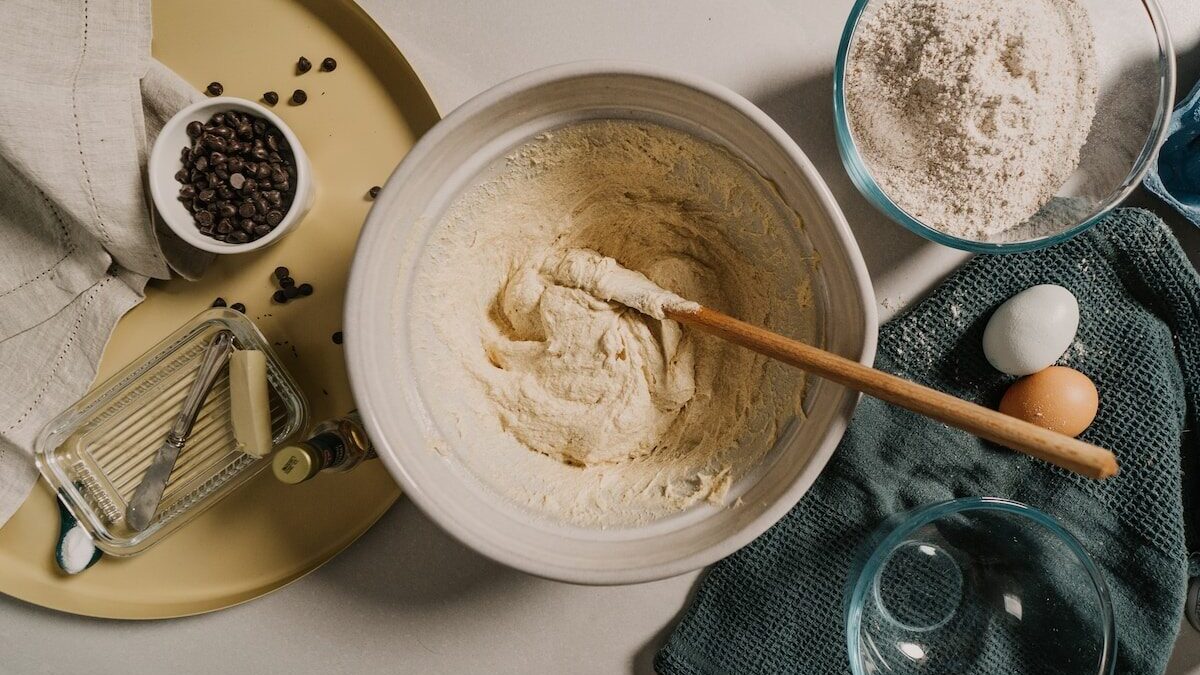
Basic batter preparation is an essential technique in baking. This involves combining all the ingredients together to make a smooth, even batter that will be used for cakes, muffins, cupcakes, or dough in the case of cookies. There are four core methods to know
The Whisking Method
Use for: sponge cakes, meringues, pavlova, and chiffon cakes.
The whisking method is a baking technique where ingredients, typically eggs and sugar, are beaten together to create a light and fluffy mixture.
To use the whisking method, the eggs and sugar are typically beaten together in a bowl using an electric mixer or by hand with a whisk until the mixture becomes pale, thick, and fluffy. This process incorporates air into the mixture, which helps to leaven the cake or other baked goods.
In some recipes, the egg yolks and sugar are whisked together first and then the egg whites are beaten separately until stiff peaks form, before the two mixtures are folded together. This helps to create a light and airy texture, particularly in sponge cakes.
It is important to ensure that the eggs are at room temperature before whisking, as this helps to achieve maximum volume. Some recipes may also call for the addition of other ingredients, such as flour, baking powder, or cream of tartar, to help stabilize the mixture and ensure that the cake rises properly during baking.
Creaming Method
Used for: cakes, cupcakes, some cookies, and recipes with high-fat content
The creaming method is a baking technique used to incorporate air into a mixture of butter and sugar, resulting in a light and fluffy texture. This method is commonly used in recipes for cakes, cookies, and other baked goods.
To use the creaming method, room-temperature butter, and sugar are first combined in a mixing bowl. The mixture is then beaten together using an electric mixer or by hand with a wooden spoon until it becomes pale and fluffy. During the mixing process, air is incorporated into the mixture, which helps to leaven the baked goods and create a light texture.
After the butter and sugar are creamed together, other ingredients such as eggs, vanilla extract, and flour are gradually added to the mixture and mixed until fully incorporated. This creates a smooth and uniform batter ready for baking.
It is important to ensure that the butter is at room temperature before creaming it with the sugar, as this allows the two ingredients to blend together more easily and create a smooth mixture. Over-creaming the mixture can cause the butter to break down and result in a dense and greasy texture, so it’s important to stop mixing once the mixture is light and fluffy.
The Melting Method
Used for: fudge brownies, chocolate cakes, cookies
The melting method is a baking technique where ingredients are melted together on low heat before adding other ingredients to create a batter or dough. This method is commonly used in recipes for fudge brownies, chocolate cakes, and some cookie recipes.
To use the melting method, the solid ingredients such as chocolate, butter, and sugar are melted together in a saucepan on low heat, stirring constantly until they are fully melted and combined. The mixture is then removed from the heat and allowed to cool slightly before adding other ingredients such as eggs, flour, and the leavening agent.
The melted mixture is typically mixed together with a whisk or wooden spoon until the batter is smooth and uniform. The batter is then poured into a greased baking dish and baked in the oven.
The melting method is a relatively simple and quick technique that can create rich and decadent baked goods. However, it’s important to be careful when melting chocolate and butter, as they can easily burn if the heat is too high or they are left unattended. Additionally, the melted mixture should be allowed to cool slightly before adding eggs, as hot ingredients can cook the eggs and cause the batter to curdle or seize up.
Rubbing-in method
Used for: pie crusts, scones, biscuits, pastries
The rubbing-in method is a baking technique used to combine fat and flour together to create a crumbly texture, commonly used for making pie crusts, scones, biscuits, and other pastries.
To use the rubbing-in method, cold fat such as butter, lard, or shortening is cut into small pieces and added to a bowl of flour. The fat is then rubbed into the flour using the fingertips or a pastry cutter until the mixture resembles coarse breadcrumbs. During this process, the fat coats the flour particles, creating small pockets of air that will expand during baking, resulting in a flaky texture.
Liquid ingredients such as cold water or milk are then added to the mixture and stirred until a dough forms. The dough is then rolled out or shaped as needed for the recipe.
It’s important to keep the fat cold during the rubbing-in process, as this helps to create a flaky texture. The mixture should be handled as little as possible to prevent overworking the dough, which can result in a tough and dense texture. The rubbing-in method requires a bit of practice to get the right consistency, but with practice, it is a reliable and versatile technique for making a range of baked goods.
3. Mastering Temperature
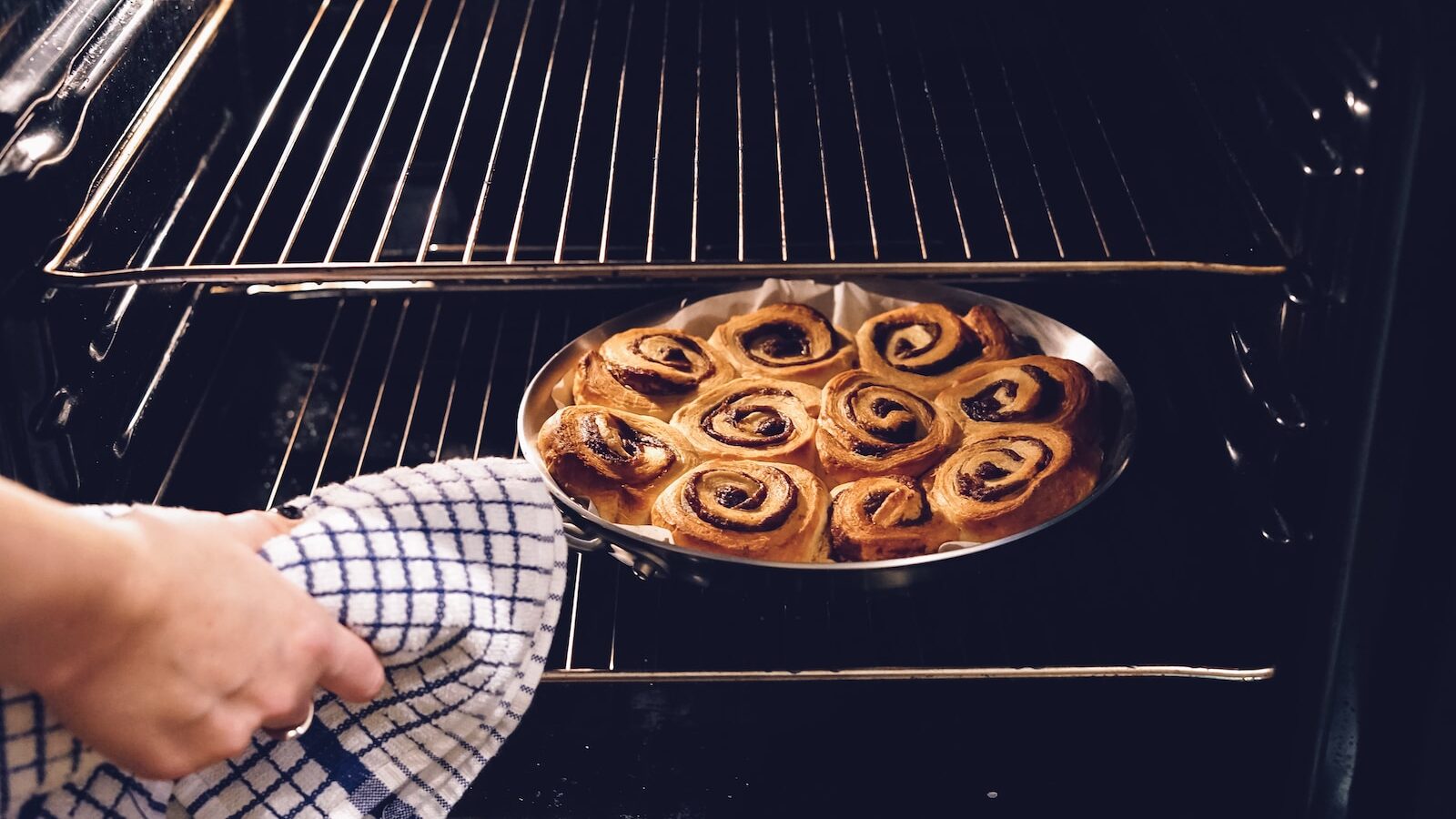
Temperature is another key to successful baking from the recipe stage through to the baking stage.
Ensure to read the recipe clearly and note suggested temperatures for ingredients, in many cases, it can be quite critical to the outcome of different stages, whipping egg whites for meringues is a good example, even more so with sugar syrups.
Having an instant-read thermometer can be incredibly helpful for measuring temp during the prep stage, and for testing doneness, along with meeting the exact temperatures required for creating sugar syrups.
Finally, we move to the oven, one of the key moments in the baking process, and the key tips here are
- Preheat the oven: Always preheat the oven for at least 10-15 minutes before baking, to ensure that it reaches the correct temperature and that the baked goods cook evenly.
- Use an oven thermometer: An oven thermometer can help ensure that the oven is at the correct temperature. It’s not uncommon for oven thermostats to be inaccurate, so using an oven thermometer can help you make sure the temperature is correct.
- Know your oven’s hot spots: It’s common for ovens to have hot spots, where certain areas are hotter than others. Knowing where these hot spots are can help you adjust the placement of your baked goods for even baking.
- Rotate pans: For even baking, rotate pans halfway through the baking time. This ensures that the baked goods bake evenly on all sides. Check the recipe first as some cakes may flop if the temp drops when opening the oven door.
- Use the correct oven rack: Different recipes may require different oven rack placements. For example, pies may need to be baked on the bottom rack to ensure that the bottom crust is fully cooked.
- Get to know your oven: If you notice that your baked goods are consistently undercooked or overcooked, you may need to adjust the oven temperature to what’s listed in the recipes. Search your oven model online for any helpful tips from other home bakers.
- Always use a timer: Use a timer to keep track of baking time as it’s guaranteed there will be something come along to distract you.
Conclusion
Master these three essential baking techniques and then everything else will begin to fall into place and you’ll soon be serving up your own wonderful creations.
Moreover, learning how to bake can also be a wonderful skill to share with family. A time for creativity and for trying new things, it can also be a relaxing activity that provides quality time together while producing something delicious for everyone to enjoy.
